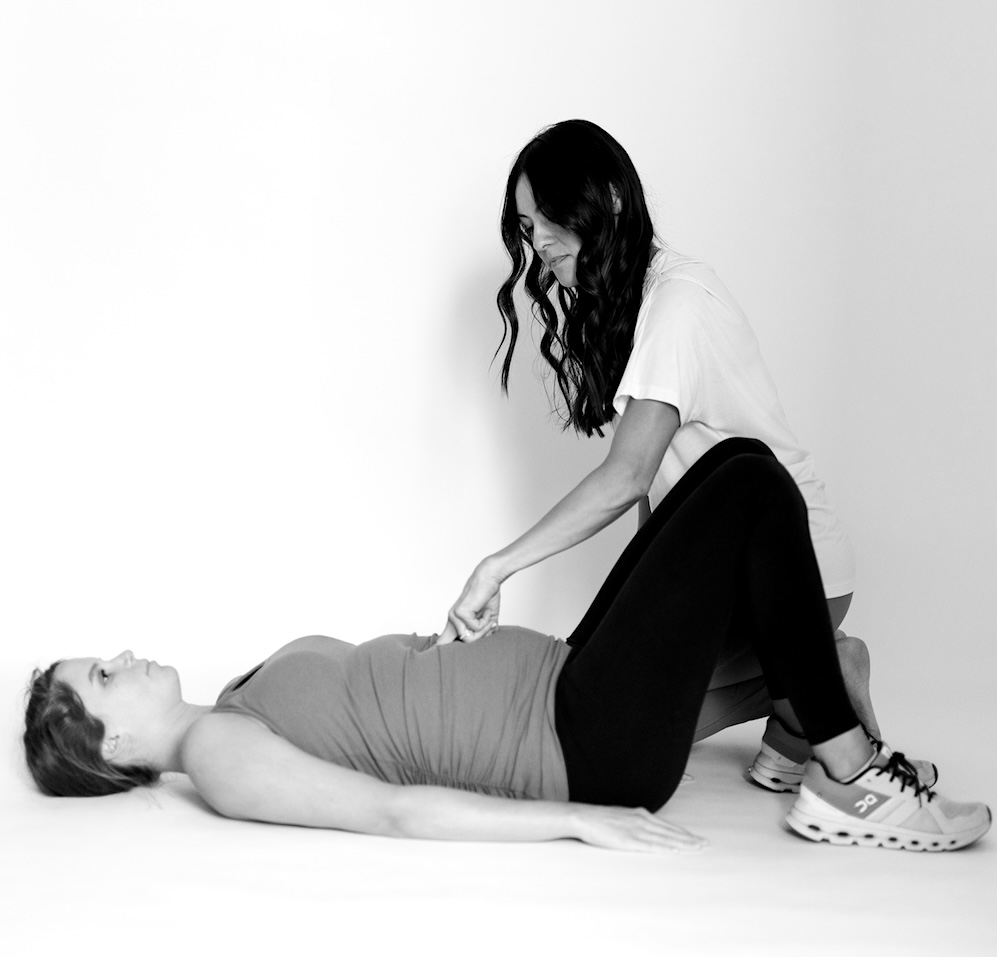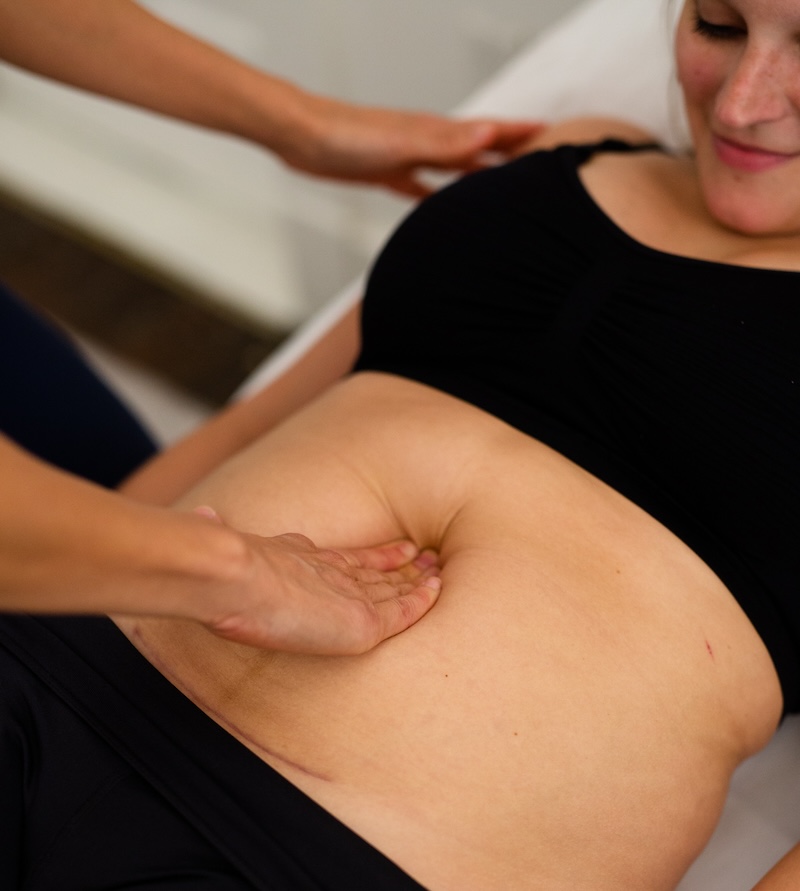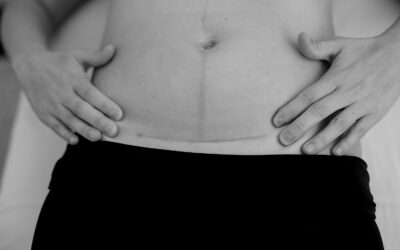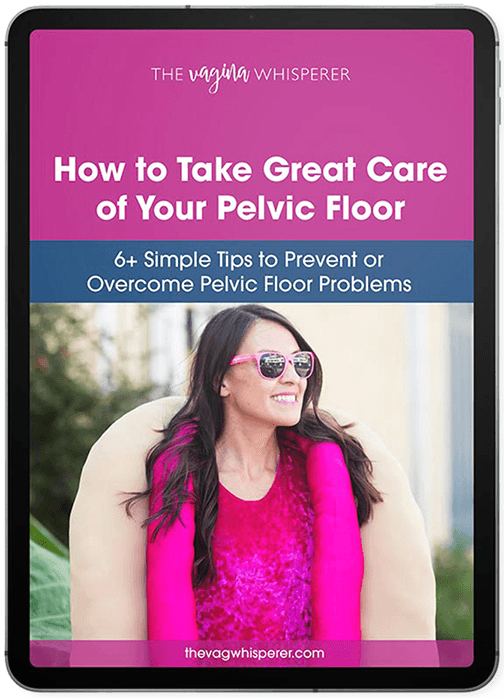If you are currently pregnant or postpartum, you’ve likely heard some mention of diastasis recti (DRA) – but are you familiar with how to know if you have diastasis recti?
Diastasis recti is when the connective tissue in the middle of your abdominal muscles separates. It happens in the rectus abdominis muscles – more commonly called the 6-pack ab muscle.
The rectus abdominis runs vertically from the sternum to the pubic bone. The midline between those ab muscles is the linea alba which is what gets thinner as your belly grows during pregnancy. Hormonal changes and pressure in the abdomen from your growing baby can stretch the linea alba, causing diastasis recti.
How to Know if you have Diastasis Recti
With diastasis recti, you may see a bulge in the midline of the abdomen when getting out of bed, leaning back to sit in a chair, or during exercises like crunches or leg lifts. That bulge means the pressure in your abdominal cavity is greater than the support the linea alba can support. So that pressure has to go somewhere and finds the place of least resistance (thin and weak abdominal wall tissues) to pop out.
Diastasis recti isn’t harmful, but it may appear scary and cause discomfort with possible additional symptoms.
There often present some common signs of diastasis recti.
- Inability to activate your abs or feeling extremely weak (especially when you previously had good core strength and endurance).
- Pulling or stretching sensation in the middle of your abdomen with crunches, planks, or other high-level core exercises.
- Doming or conning with lifting during daily activities or exercise, with core/ab exercises, or with bowel movements.
How Do You Check for Diastasis Recti?
You can check for Diastasis Recti by lying on your back, with knees bent and feet flat on the floor. Without engaging your abs, lift your head and shoulders off the floor like you’re performing a mini crunch. Then take your fingertips and gently press along the midline of your abdomen.
Chances are you have some level of diastasis if:
- Your fingers sink in at least to the first knuckle
- You see a doming of your abs in the midline often described as a football- like bulge in your tummy
Diastasis Recti can happen above, below, or at your belly button. You should examine all three parts of your stomach muscles.
What Does Diastasis Recti Feel Like?
When doing the test, it’s normal to feel a gap (about two finger widths apart) between the muscles in the abdomen. However, it’s not just about how wide the gap is – but also how deep.
If your fingers can easily press into the muscles and it feels soft without any pushback, you may have diastasis recti. If your ab muscles feel tense or springy, it means they can handle pressure. This is a good sign that you likely don’t have diastasis recti.
Risk Factors for Diastasis Recti
Diastasis recti can occur anytime, in anyone – whether pregnant or not.
It is more likely to occur:
- During the second or third trimester of pregnancy
- Postpartum within the first year
- If you have previously had diastasis recti
- With a pelvic floor disorder
- With repetitive straining exercises
Additional risk factors include:
- High-intensity activity like running, HIIT classes, Crossfit, or powerlifting too quickly after childbirth
- Multiple pregnancies close together, especially within 18 months of one another.
- Women who are pregnant with multiples.
- High birth weight of the baby.
- Genetics, having a mom who also experienced diastasis recti during pregnancy
How to Help Prevent It
Certain risk factors for diastasis recti during pregnancy cannot be controlled. However, there are still ways to reduce the risk or severity of this condition. These include:
- Modify your activity early on in the pregnancy
- Manage constipation and avoid breath-holding when you poop
- Use a slow, controlled exhale with all lifting instead of holding your breath
- Avoid activities that cause doming, conning, or pain in the midline of the abdomen
- Wear support garments like the baobei maternity postpartum support bloomers or the mom-ez support belt, as needed.
Frequently Asked Questions About Diastasis Recti
#1 Does DR Go Away?
Diastasis Recti may resolve on its own but oftentimes persist without exercise and activity modification. Learning and practicing specific exercises can help strengthen and support the deep abdominal muscles and the linea alba.
Studies have also shown a connection between pelvic floor muscle dysfunction and diastasis recti during pregnancy.
Make sure to check in with a pelvic health physical therapist or follow along an at home workout program like the V-Hive membership to strengthen your pelvic floor and core muscles!
#2 What Are Some Exercises for DR?
There are many exercises you can do to help heal your DR. However, strengthening your core is less about what you can or cannot do, but about how you do it.
Learning to control your abdominal pressure and engage your lower abs in exercise and daily tasks can be beneficial. You can do push-ups, planks, and crunches by tightening your abdominal muscles. This can actually help improve diastasis recti and reduce abdominal separation.
#3 Can I Have DR Without Being Pregnant?
Having diastasis recti without being pregnant is possible (even males can get it!), though it is most common in pregnant and postpartum women.
#4 How Do I Get In and Out of Bed with Diastasis Recti?
If you are pregnant and have diastasis recti:
- Sit down, lie on your side and then lift your legs into the bed so you are lying completely on your side.
- Roll onto your back once you are completely on the bed.
- To get out of bed, roll to your side first to bring your arm across your chest then roll to the side.
- Lower your legs off the edge of the bed and use your arms to push up. This helps protect your abs, back, and pelvic floor.
#5 Can Diastasis Recti Cause Other Issues?
Women with diastasis recti may have issues with their pelvic floor. These issues can include urine leakage, difficulty controlling bowel movements, and pelvic organ prolapse.
Diastasis recti is important to address because it can cause low back pain, weak abdominal muscles, and bad posture.
Treatments for Diastasis Recti
Non-invasive Treatment Options
If you are certain you have diastasis, don’t be alarmed – there are multiple treatment options available!
- Pelvic health physical therapy can help address diastasis recti
- Using a home workout program like the V-Hive Strengthening Series can help address both pelvic floor and core support.
- Physical therapists do not always recommend a belly binder. However, a compressive support can help you feel better and hide any bulges that bother you.
Surgical Intervention
Diastasis recti may require surgical intervention if diastasis depth or width does not improve. Surgery is also an option to improve pain, discomfort or the way your tummy looks.
Surgery is possible if you meet certain conditions. You can qualify if you gave birth over a year ago, don’t want more kids, stopped lactating, or have a painful hernia. Consult a general surgeon or plastic surgeon with experience in diastasis recti repair.
It’s not always easy to identify how to know if you have diastasis recti – but a virtual consultation with a board certified physical therapist can help! One on one consultations are discounted with the V-Hive membership – try it out with a 7 day free trial today!






